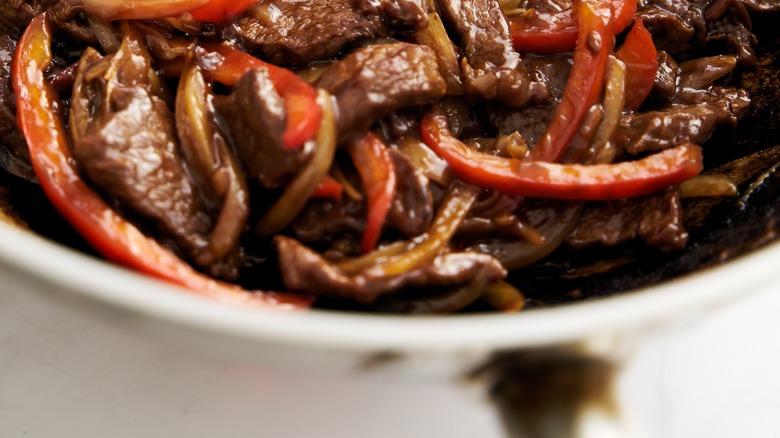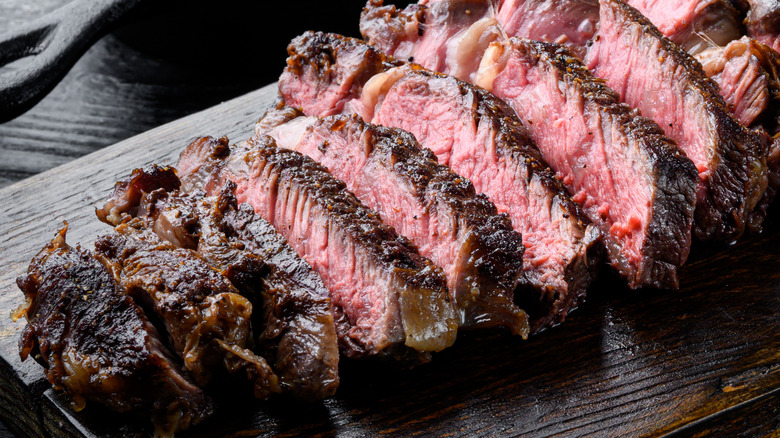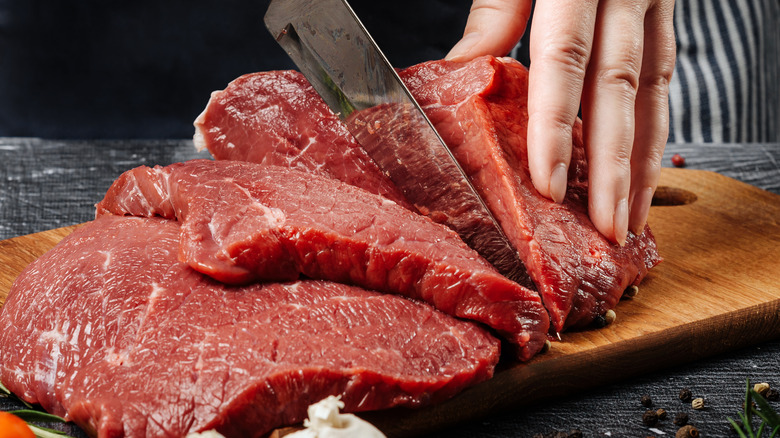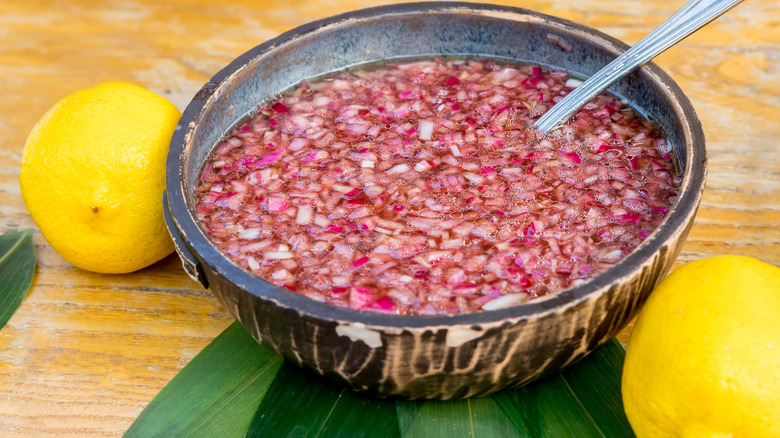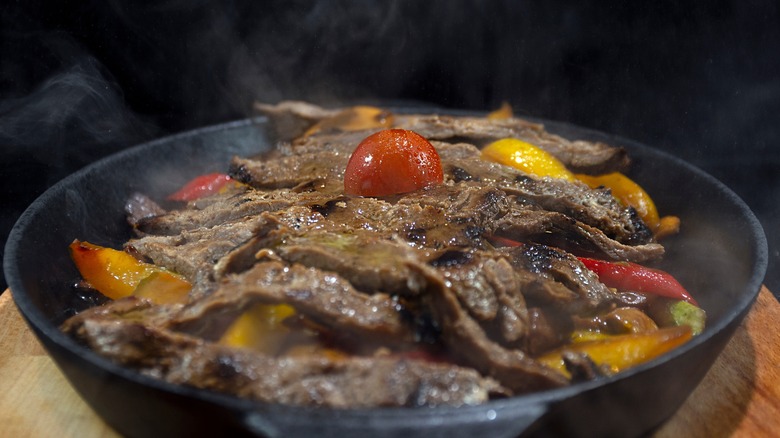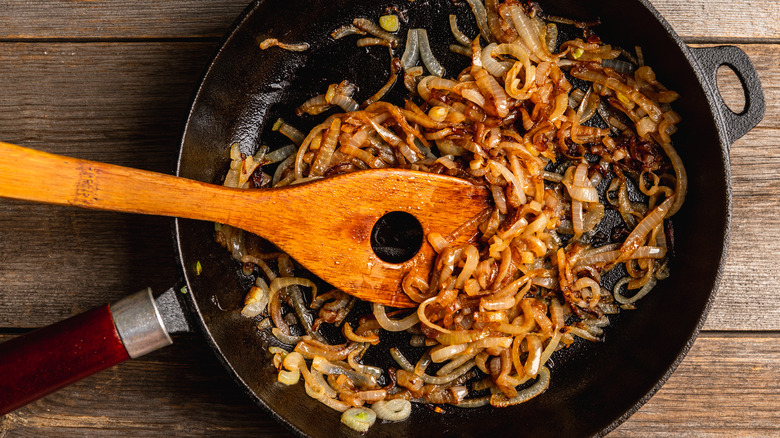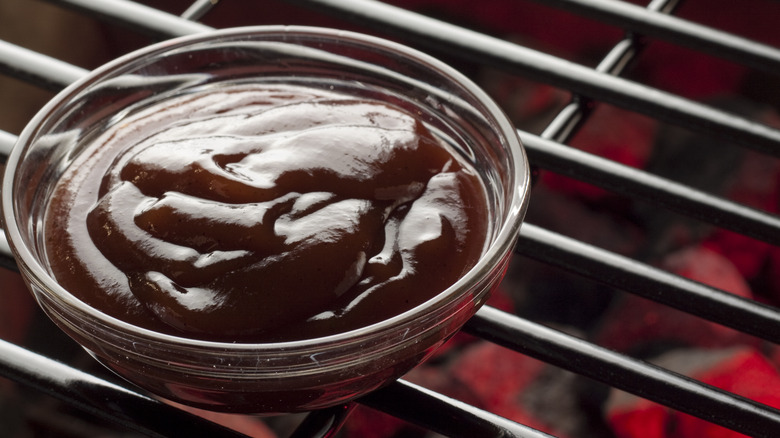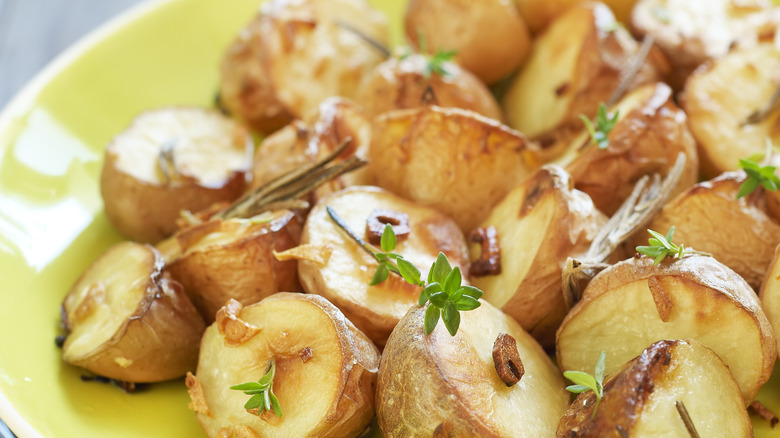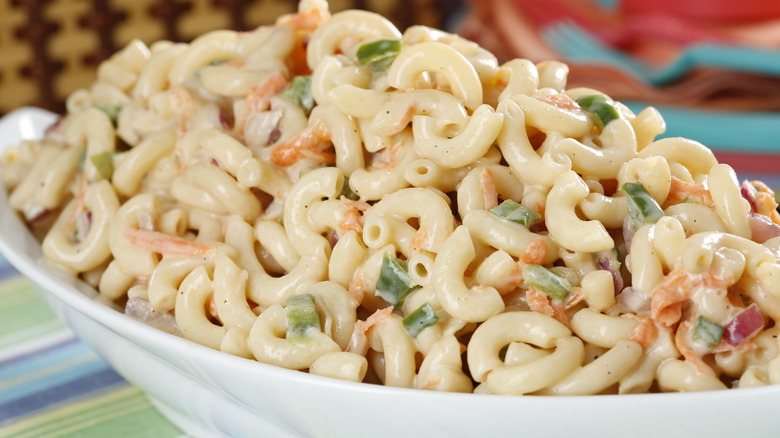Why Hawaiian Chopped Steak Needs To Be Part Of Your Stir-Fry Repertoire
Like so many dishes that put chefs on the map, the Hawaiian chopped steak that James Martin served on "The Great Food Truck Race" came from the matriarchs of his family. "My grandma ... she loves a lot of stir-fries, you know, whatever she could find in the refrigerator, the ice box, she would throw together with some protein," the Da Bald Guy founder told Tasting Table.
It's a dish that drew crowds of hungry food truck customers on the hit Food Network show. While Da Bald Guy would ultimately bow out of the competition in its semi-final (episode 6, "Family Food"), Martin's Hawaiian chopped steak stands as a testament to the stand-out simplicity of his comfort-food style cooking. "I put a lot of love and effort into my food," he told us. "I take a lot of time and effort finding the best product [and] the best ingredients to present that a dish."
Why does Hawaiian chopped steak need to be part of your stir-fry repertoire? It's both a delicious, simple way to assuage your appetite for beef and a homage to the flavors of the Hawaiian islands, which Martin describes as a melting pot of Japanese, Chinese, Korean, Mediterranean, French, and Portuguese flavors. "I think as Hawai'ian, you try to stand out because it's such a small island, right? And so everybody's trying to develop their own flavors, their own, um, twist and unique taste to everything," Martin reflected. "Everybody takes those homegrown flavors, and they incorporate it into the Hawaiian, the local culture."
Elevate your Hawaiian chopped steak with a quality cut of meat
Da Bald Guy mastermind James Martin is hardly a food traditionalist. In this case, that works in your favor because he offered us two ways to prepare Hawaiian chopped steak. To follow more traditional recipes like the ones that Martin drew inspiration from, use a "cheap cut of meat" like chuck eye steak eye steak or boneless short rib. Go this route, and you'll want to mix your steak with plenty of vegetables. Martin says that mushrooms, bell peppers, carrots, celery, and onions are commonly added to the Hawaiian chopped steaks he grew up with.
For a more meat-centered version of the dish, copycat Martin's "The Great Food Truck Race" offering and opt for minimal veggies and quality meat. "I'm all about highlighting protein more than anything," Martin told us. "You can really taste a difference when you provide quality proteins." The Da Bald Guy owner — himself — prefers ribeye, which he says elevates the traditional comfort food to what he calls "that fine dining standard." Making your Hawaiian chopped steak with a quality cut like ribeye has an added advantage: You'll avoid using the meat tenderizer that cheaper cuts often require.
The best way to cut your Hawaiian chopped steak
When cutting your beef for a Hawaiian chopped steak, keep two culinary dictums in mind. First — as you would when preparing most other steaks — you'll want to cut your ribeye, chuck, or short rib against the grain, says James Martin. That'll make the steak easier to chew, and per Da Bald Guy owner, "you always have that consistency of tenderness."
Second, consider what thickness is ideal for sautéed strips. Go too thin and risk overcooking your beef when it hits a heated pan. Go too thick, and you're in for red meat. "I like to cut [my ribeye] about an inch thick," said Martin. Inch-thick strips are optimal for fans of medium-rare doneness level, especially because you're aiming for a high-heat cook to produce the perfect texture and sear. Your finished steak should have "a little crust on the outside, but the inside is still, you know, medium rare, medium," the food truck contestant told us.
A Hawaiian chopped steak needs a quick marinade
Yes, a Hawaiian chopped steak does require a bit of thinking ahead. Marinade prep time, however, isn't something that'll work up a sweat. You're in for a drastically shorter time commitment than the two hours you'd need to set aside when preparing — say — a carne asada. Because you'll cut your beef into one-inch strips before soaking it, quick marinades are best. James Martin recommends marinating your Hawaiian chopped steak meat for between 30 minutes and an hour.
On the islands, Hawaiian chopped steak is traditionally marinaded in "a sweet, salty sauce, usually like a teriyaki, [or], an oyster sauce," Martin tells us. The Da Bald Guy owner prepares his own take on traditional marinades, preparing simple "oyster-based" sauce with a little pepper, garlic, and salt. "You just toss it together, you let it marinade, [and] you get that little saltiness, you know, that comes through, and then after you cook it," the chef explained.
Avoid failure by cooking your Hawaiian chopped steak on high heat
Listen up, aspiring Hawaiian chopped steak experts; you're now entering the big leagues. Like most steak recipes, a great Hawaiian chopped steak will have the perfect sear and crust on the outside but remain tender on the inside. Because you're cooking your steaks in one-inch strips, however, the cooking process may be different than you're used to. "First and foremost, make sure your heat is high enough," Martin advised us. High-heat cooking will achieve two things. First, says the food truck owner, it will "seal in those flavors from the proteins." Second, it will give your meat the desired crunchy and charred outside, safeguarding it against "soft and soggy" results.
For an evenly cooked dish, prepare your Hawaiian chopped steak in small batches, even if that means adding to your overall cooking time. Overcrowding your meat in the pan, says Martin, is a recipe for inconsistent beef. At optimal thickness and temperature, it should take five to six minutes to achieve the sear, crust, and charr you're aiming for. Toss in your desired veggies immediately after the steak is cooked.
Serve your Hawaiian chopped teak with caramelized onions
Opt for a more traditional Hawaiian chopped steak, and you'll add sauteed peppers, carrots, and celery to your dish immediately after your steak is cooked. Do it James Martin's way, and you'll only need to prepare caramelized onions. These, he insists, are the only add-ins necessary to give the dish "another depth of flavor."
While caramelizing them is — admittedly — a time-zapper, it's well worth the effort, according to Martin. "It's not going to be a quick process. Usually, it takes me about an hour and a half to two hours, " the Food Truck owner told us. "That's the first thing we start cooking when we open up the truck is the caramelized onions." For the best results and optimal onion sweetness, sauté the root vegetable "low and slow" until, per Martin, they "become translucent." The longer you cook them, the sweeter they'll become. Remember to prepare your onions ahead of time. That way, when you're steak is cooked to medium rare, your onions will be ready for immediate mixing.
Make a Hawaiian barbecue sauce for your Hawaiian chopped steak
Making your own Hawaiian barbecue sauce to complement your Hawaiian chopped steak is easy sailing. You can, of course, pick out your favorite store-bought barbecue sauce, but the sauce that James Martin came up with for the steak he serves on Da Bald Guy is soy sauce heavy. Per Martin, a soy base — as opposed to ketchup or vinegar — adds an extra sweet-and-salty kick to your dish. To copycat the sauce he serves, mix soy sauce, brown sugar, rice wine vinegar, and oyster sauce and "thicken it up" before tossing it with your marinated, sauteed ribeye and caramelized onions. Et Voilà! You've reached the finish line.
Have you also noticed that Martin is oyster sauce's number-one fanboy? He grew up watching his grandmother using the sauce and has come to rely on it to complement salt in his cooking. "I love oyster sauce," the food truck owner told us. "It gives umami instead of just saltiness to [your recipe]."
Potatoes make great sides for Hawaiian chopped steak
What should you serve to accompany Hawaiian chopped steak? While there is no single right answer, the garlic potatoes that Da Bald Guy served on "The Great Food Truck Race" is most certainly not the wrong way to go.
Like his Hawaiian chopped steak recipe, James Martin's garlic potatoes recipe comes from a cherished childhood food memory. "Back here on the islands, we have these things called Korean barbecue places," Martin explained. "One of the side dishes that they would give would be the garlic potatoes, and I loved eating that." It's a simple dish to get right. Dice russet potatoes — skin on — into "bite-sized" pieces, pre-blanche them until — per Martin — they're "soft enough to where a fork could go through," drain them, and deep fry them. While they're cooking, prepare an aioli by mixing mayo (Martin prefers Best Foods or Hellmann's) and fresh garlic. The simple, delicious dish is what Martin's brand is all about. "I try to take simple ingredients and make it the best," the food truck owner told Tasting Table. "[I'm all about] taking that comfort level of food and hitting home with it and perfecting it."
Personalize your Hawaiian chopped steak by serving it on pasta, mashed potatoes, or a salad
If you choose to serve your Hawaiian chopped steak over rice, James Martin recommends that you invest in a rice cooker and go with a medium-grain variety. Of course, rice — or even crispy garlic potatoes — aren't your only options to complement the dish. Nor, says Martin, should you limit yourself for the sake of traditionalism or to emulate his style of cooking.
On his food truck, Martin usually serves his Hawaiian chopped steak up with a mayo-based, garlicky macaroni salad. You can also serve it with a Caesar salad, a green salad, Okinawan sweet potatoes, mashed potatoes, mac-and-cheese, or other pasta dishes. "Just make it your own. Have fun with it," Martin urged us. "Mix and match ingredients, try it out, and see what flavors you like." If you're not a fan of soy-based sauces, no problem. "Maybe add barbecue sauce ... like some Kansas City barbecue sauce or, you know, Memphis barbecue sauce," Martin suggested. "Maybe toss it with some cream, you know, you can make like a stroganoff with it ... It's endless possibilities. Think outside the box and, you know, have fun with it."
